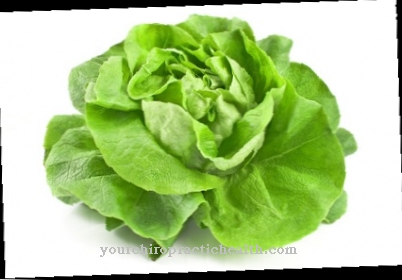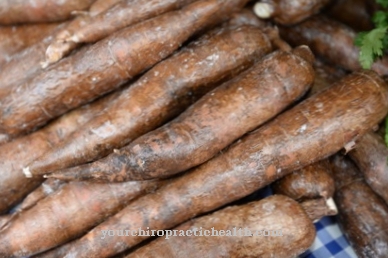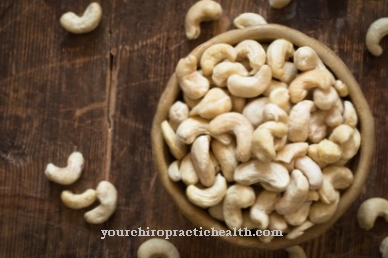yogurt is a traditional food that consists of milk that has been thickened by lactic acid bacteria and therefore tastes slightly sour. Yoghurt is available on the market both straight and with various fruit additives. Natural yoghurt forms the basis of various other dishes and is also used in medicine.
What you should know about yogurt

The name yogurt comes from Turkish and means "fermented milk". This points not only to the way in which this food was made, but also to the history of this food. Yogurt is one of the oldest known dairy products.
Early on, cattle-keeping peoples realized that under certain circumstances milk fermented and thus became more durable. In Central Asia, the Middle East and the Mediterranean in particular, yogurt is an integral part of traditional cuisine. In Central Europe yoghurt has only been widespread since the beginning of the 20th century. With the discovery of lactic acid bacteria and improved cooling options, targeted production became possible.
Instead of waiting for a chance acidification and thickening of the milk, lactic acid cultures are used today to achieve the desired result. These usually convert the lactose contained in milk into lactic acid at temperatures between 40 ° C and 50 ° C. This gives yoghurt its characteristic sour taste and becomes firm. Yoghurt is now one of the most popular and widely used dairy products.
Importance to health
The fermentation makes yogurt a particularly digestible food. Since the lactic acid bacteria used in the production process partially break down the lactose contained in the milk, yogurt is also more tolerable than normal milk for people with lactose intolerance.
Even if there is no lactose intolerance, yogurt is much easier to digest than other dairy products. If the yoghurt still contains living cultures, it even actively promotes health: the lactic acid bacteria contained in yoghurt make the intestinal surface more resistant, weaken the symptoms of intestinal diseases and regulate digestion. Yogurt can also be used externally. Wraps with yoghurt can have a cooling effect on sunburn and other burn injuries and on skin diseases such as Acne improves the complexion. For fungal infections of the genital area, a tampon can be dipped in yogurt with live cultures and inserted. The lactic acid bacteria contained in it counteract the yeast fungi.
Ingredients & nutritional values
| Nutritional information | Amount per 100 gram |
| Calories 59 | Fat content 0.4 g |
| cholesterol 5 mg | sodium 36 mg |
| potassium 141 mg | carbohydrates 3.6 g |
| protein 10 g | Fiber 0 mg |
The main area of application for yogurt is of course in nutrition. Compared to other dairy products, yogurt is usually quite low in calories. This means that it can also be consumed in large quantities without any problems.
It is very rich in protein and has a comparatively high proportion of calcium. This makes it particularly good for bones and teeth. It also contains numerous vitamins and trace elements, including vitamin B12, which is otherwise only found in meat. A deficiency in vitamin B12 can lead to serious secondary diseases. Therefore, vegetarians in particular should make sure to supplement their diet with yogurt and other dairy products.
Intolerances & allergies
Since the lactose contained in the milk is not completely broken down during yoghurt fermentation, people who are sensitive to lactose or are even lactose intolerant can react to the consumption of yoghurt with more or less severe digestive problems. In the case of lactose intolerance, the milk sugar that is still contained in yoghurt is not or not completely broken down.
It therefore reaches the large intestine, where it is broken down by intestinal bacteria. This can lead to severe gas and diarrhea. Nausea and vomiting are also not uncommon, as are unspecific symptoms such as tiredness, headaches and depressive moods. Anyone who finds that digestive problems or other symptoms occur in connection with the consumption of yogurt should therefore be examined for lactose intolerance. But even those who actually have health problems in this area no longer have to do without yoghurt and its benefits. Numerous manufacturers now also offer lactose-free yogurt in different flavors.
Shopping & kitchen tips
Yoghurt is available in all supermarkets from a large number of manufacturers and both pure and in different flavors. Natural yogurt consists exclusively of milk and lactic acid bacteria without any other additives. It only differs in the fat content.
The most common fat level is a fat content of at least 3.5 percent. Low-fat yogurt, on the other hand, only has a fat content of 1.5 to 1.8 percent, yogurt made from skimmed milk only 0.5 percent. In contrast, cream yogurt with a fat content of at least 10 percent is very high in calories. Particularly in the case of a low-calorie diet, attention should be paid to the fat content of the yogurt. Yogurt in different flavors can differ significantly in the ingredients. A yoghurt may only be called fruit yoghurt if the fruit content is above 6 percent. For yoghurt with fruit preparations, the fruit content must be at least 3.5 percent. If it is lower, it is fruit-flavored yogurt.
It is important to ensure that the actual fruit taste does not necessarily have to come from the fruit itself, but can also be created using artificial or nature-identical aromas. Apparent pieces of fruit can also be obtained from fruit residues using gelling agents. When purchasing finished fruit yoghurt, attention should therefore be paid to the quality level. Other possible ingredients are sugar, artificial sweeteners, thickeners and preservatives. In addition, ingredients such as cereals and nuts are allowed. These also have a significant effect on the calorie content of the yogurt. It is therefore advisable to pay attention to the list of ingredients and the nutritional information when shopping.
In addition to natural yoghurt and fruit yoghurt, there are also specialties such as flavored yoghurt, e.g. with vanilla flavor, drinking yoghurt, Greek yoghurt, which is significantly firmer than conventional yoghurt, as well as various hearty yoghurt preparations. All types of yogurt should be kept refrigerated after purchase. The middle compartment of the refrigerator, which should have a temperature of around 5 ° C, is best for this. After opening the pack, however, the yoghurt should be eaten soon, even if the refrigeration continues, because mold can easily settle.
Preparation tips
Yoghurt that has been bought ready-made can be consumed without further preparation or used to prepare meals. However, it is also very easy to make yogurt at home. To do this, milk is heated to 90 ° C for a few minutes in order to add existing bacteria. Then yoghurt cultures are added.
These are available by mail order. It is also possible to use previously purchased yoghurt with living yoghurt cultures instead. In this case, about 150 g of yoghurt are required for one liter of milk. The mixture is then poured into glasses and placed in the 50 ° C oven for half an hour. After cooling, the finished yogurt should be stored in the refrigerator and consumed within three to four days. Yoghurt preparation is even easier with an electric yoghurt maker.













.jpg)

.jpg)
.jpg)











.jpg)